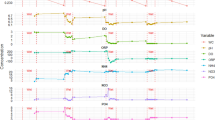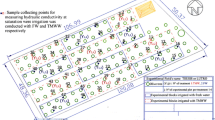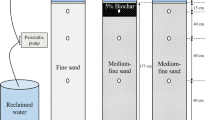Abstract
Coal bed natural gas (CBNG) extraction in the Powder River (PR) Basin of Wyoming and Montana produces modestly saline-sodic wastewater, which may have electrical conductivity (EC) and sodium adsorption ratios (SAR) exceeding accepted thresholds for irrigation (EC = 3 dS m−1, SAR = 12 (mmolc l−1)1/2. As an approach to managing large volumes of CBNG-produced water, treatment processes have been developed to adjust produced water salinity and sodicity to published irrigation guidelines and legislated in-stream standards. The objective of this laboratory study was to assess acute and chronic soil solution EC and SAR responses to various wetting regimes simulating repeated flood irrigation with treated CBNG product water, followed by single rainfall events. Fifty-four soil samples from irrigated fields in southeast Montana were subjected to simulated PR water or CBNG water treated to EC and SAR values accepted as thresholds for designation of saline × sodic water, in a single wetting event, five wetting–drying events, or five wetting–drying events, followed by leaching with distilled water. Resultant saturated paste extract EC (ECe) and SAR of soils having <33% clay did not differ from one another, but resulting ECe and SAR were all less than those for soil having >33% clay. Repeated wetting with PR water having EC of 1.56 dS m−1 and SAR of 4.54 led to SAR <12, but brought ECe near 3 dS m−1. Repeated wetting with water having salinity = 3.12 dS m−1 and SAR = 13.09 led to ECe >3 dS m−1 and SAR near 12. Subsequent inundation and drainage with distilled water, simulating rainfall-quality leaching, reduced ECe and SAR more often in coarse-textured, high salt content soils than in finer-textured, lower salt content soils. Decreases in ECe upon leaching with distilled water were of greater magnitude than corresponding decreases in SAR, reinforcing supposition of sodium-induced dispersion of fine-textured soils as a consequence of rainfall following irrigation with water having salinity and sodicity levels equal to previously published thresholds.





Similar content being viewed by others
References
Abo-Ghobar HM (1993) Influence of irrigation water quality on soil infiltration. Irrigation Sci 14(1):15–19
Allison JD, Brown DS, Novo-Gradac KJ (1991) MINTEQA2/PRODEFA2, a geochemical assessment model for environmental systems, Version 3.0 User’s Manual (EPA/600/3-91/021), U.S. EPA Office of Research and Development Environmental Research Laboratory, Athens, GA
Ayers RS, Westcot DW (1976) Water quality for agriculture. In: FAO Irrigation and Drainage Paper No. 29, Rev. 1, Food and Agriculture Organization of the United Nations, Rome
Bauder JW, Brock TA (2001) Irrigation water quality, soil amendments, and crop effects on sodium leaching. Arid Lands Res Manage 15:101–113
Bresler E, McNea BL, Carter DL (1982) Saline and sodic soils: principles, dynamics, modeling. Springer, Berlin
Buckland GD, Bennett DR, Mikalson DE, de Jong E, Chang C (2002) Soil salinization and sodication from alternate irrigations with saline-sodic water and simulated rain. Can J Soil Sci 82:297–309
Curtin D, Steppuhn H, Selles F (1994) Structural stability of Chernozemic soils as affected by exchangeable sodium and electrolyte concentration. Can J Soil Sci 74:157–164
De Bruin RH, Lyman RM (2000) Coalbed methane in Wyoming in Coalbed methane and Tertiary geology, Powder River Basin. In: Miller WR (ed) 50th Field Conference Guidebook. Wyoming Geological Association, Casper
Gee GW, Bauder JW (1986) Particle-size analysis. In: Page AL (ed) Methods of soil analysis, Part 1, Physical and mineralogical methods, Agronomy Monograph 9, 2nd edn. American Society of Agronomy, Madison
Hanson B, Grattan SR, Fulton A (1999) Agricultural salinity and drainage. University of California, Division of Agricultural and Natural Resources Publication #3375, University of California, Davis
Harron WRA, Webster GR, Cairns RR (1983) Relationships between exchangeable sodium and sodium adsorption ratio in a Solonetzic soil association. Can J Soil Sci 63:461–467
Keren R, Shainberg I (1981) Effect of dissolution rate on the efficiency of industrial and mined gypsum in improving infiltration of a sodic soil. Soil Sci Soc Am J 45:103–107
Mace JE, Amrhein C (2001) Leaching and reclamation of a soil irrigated with moderate SAR waters. Soil Sci Soc Am J 65:199–204
Mamedov AI, Shainberg I, Levy GJ (2000) Irrigation with effluent water: Effect of rainfall energy on soil infiltration. Soil Sci Soc Am J 64:732–737
McBeth IH, Reddy KJ, Skinner QD (2003) Chemistry of coalbed methane product water in three Wyoming watersheds. J Am Water Res Assoc 39:575–585
Miller RW, Gardiner DT (2001) Soils in our environment, 9th edn. Prentice-Hall, Upper Saddle River, New Jersey 07458. ISBN 0-13-020036-0
Mitchell AR, van Genuchten MT (1992) Shrinkage of bare cultivated soil. Soil Sci Soc Am J 54:1036–1042
Oster JD (1994) Irrigation with poor quality water. Ag Water Manage 25:271–297
Quirk JP, Schofield RK (1955) The effect of electrolyte concentration on soil permeability. J Soil Sci 6:163–178
Rice DD (1997) Coal bed methane—an untapped energy resource and an environmental concern (FS-019–97), U.S. Geological Survey, Reston
Rice CA, Bartos TT, Ellis MS (2002) Chemical and isotopic composition of water in the Fort Union and Wasatch Formations of the Powder River basin, Wyoming and Montana: implications for coalbed methane development. In: Schwochow SD, Nuccio VF (eds) Coalbed methane of North America, II: Rocky Mountain Association of Geologists guidebook. Rocky Mountain Association of Geologists, Denver
Richards LA (ed) (1954) Diagnosis and improvement of saline and alkali soils [Online]. Available at: http://www.ussl.ars.usda.gov/ hb60/hb60.htm (verified 17 June 2004). Agriculture Handbook No. 60. USDA, Riverside
So HB, Aylmore LAG (1993) How do sodic soils behave? The effects of sodicity on soil physical behaviour. Aust J Soil Res 31:761–777
Soil Survey Staff (1975) Soil taxonomy: a basic system of soil classification for making and interpreting soil surveys. In: Agricultural Handbook 436, Soil Conservation Service, Washington
SPSS, Inc (1997) SigmaStat statistical software version 2.0. SPSS, Chicago
Steel RGD, Torrie JT (1960) Principles and procedures of statistics, with special reference to the biological sciences. McGraw-Hill, New York
Suarez DL, Wood JD, Lesch SM (2006) Effect of SAR on water infiltration under a sequential rain-irrigation management system. Agric Water Manage 86:150–164
US Department of Agriculture (USDA) (1971) Soil survey of the Powder River area, Montana. National Cooperative Soil Survey, Washington
USDA (1976) Soil survey of Dawson County, Montana. National Cooperative Soil Survey, Washington DC
USDA (1996) Soil survey of Prairie County, Montana. National Cooperative Soil Survey, Washington DC
USDA (2003) Soil survey of Custer County, Montana. National Cooperative Soil Survey, Washington DC
US Salinity Laboratory Staff (1954) Diagnosis and improvement of saline alkali soils In: USDA Agricultural Handbook No. 60. US Government Printing Office, Washington DC
Western Fertilizer Handbook (1995) Soil Improvement Committee, California Fertilizer Association. Interstate Publishers, Danville
Author information
Authors and Affiliations
Corresponding author
Additional information
Communicated by J. Ayars.
Rights and permissions
About this article
Cite this article
Bauder, J.W., Hershberger, K.R. & Browning, L.S. Soil solution and exchange complex response to repeated wetting–drying with modestly saline–sodic water. Irrig Sci 26, 121–130 (2008). https://doi.org/10.1007/s00271-007-0078-8
Received:
Accepted:
Published:
Issue Date:
DOI: https://doi.org/10.1007/s00271-007-0078-8




